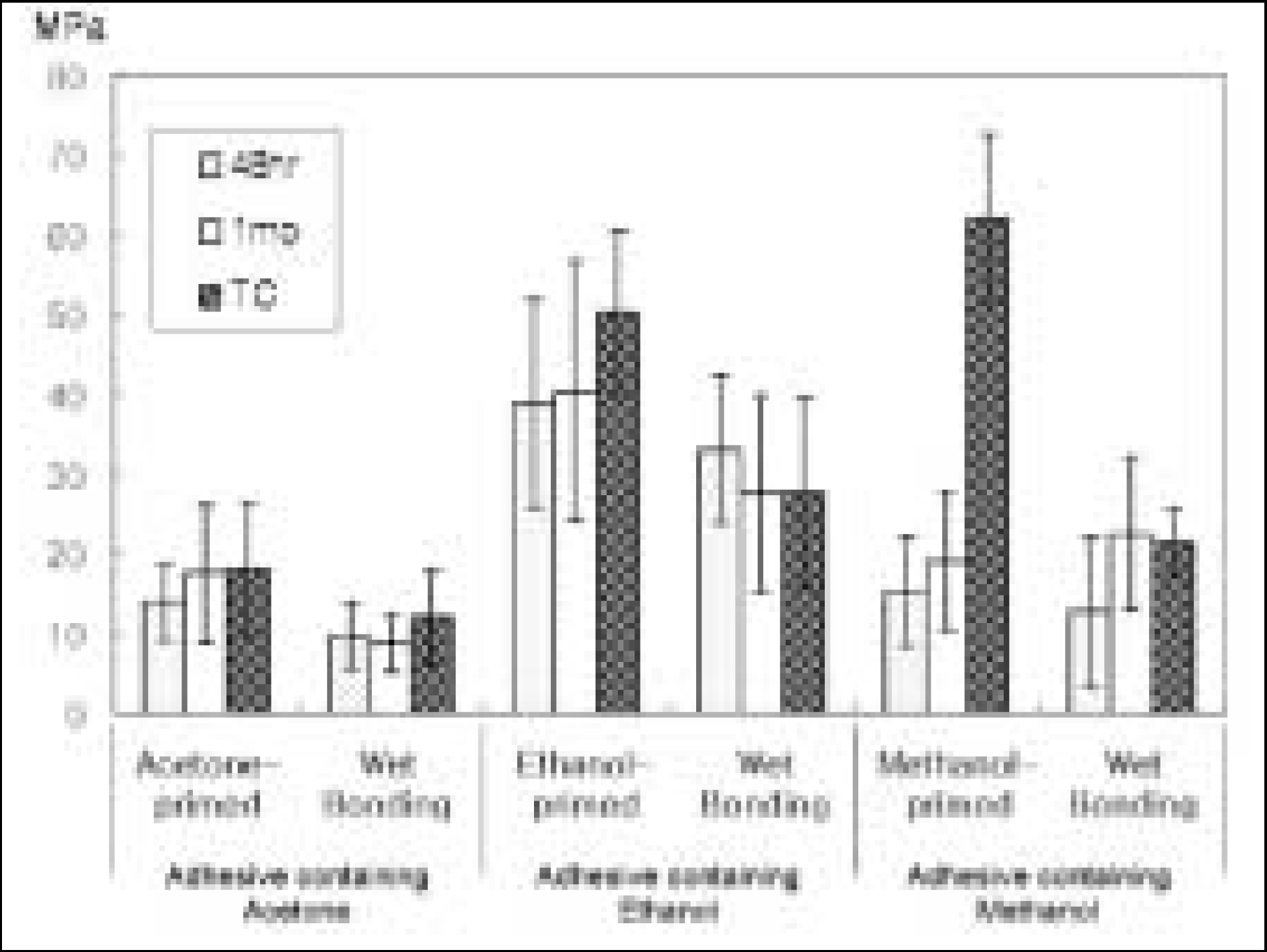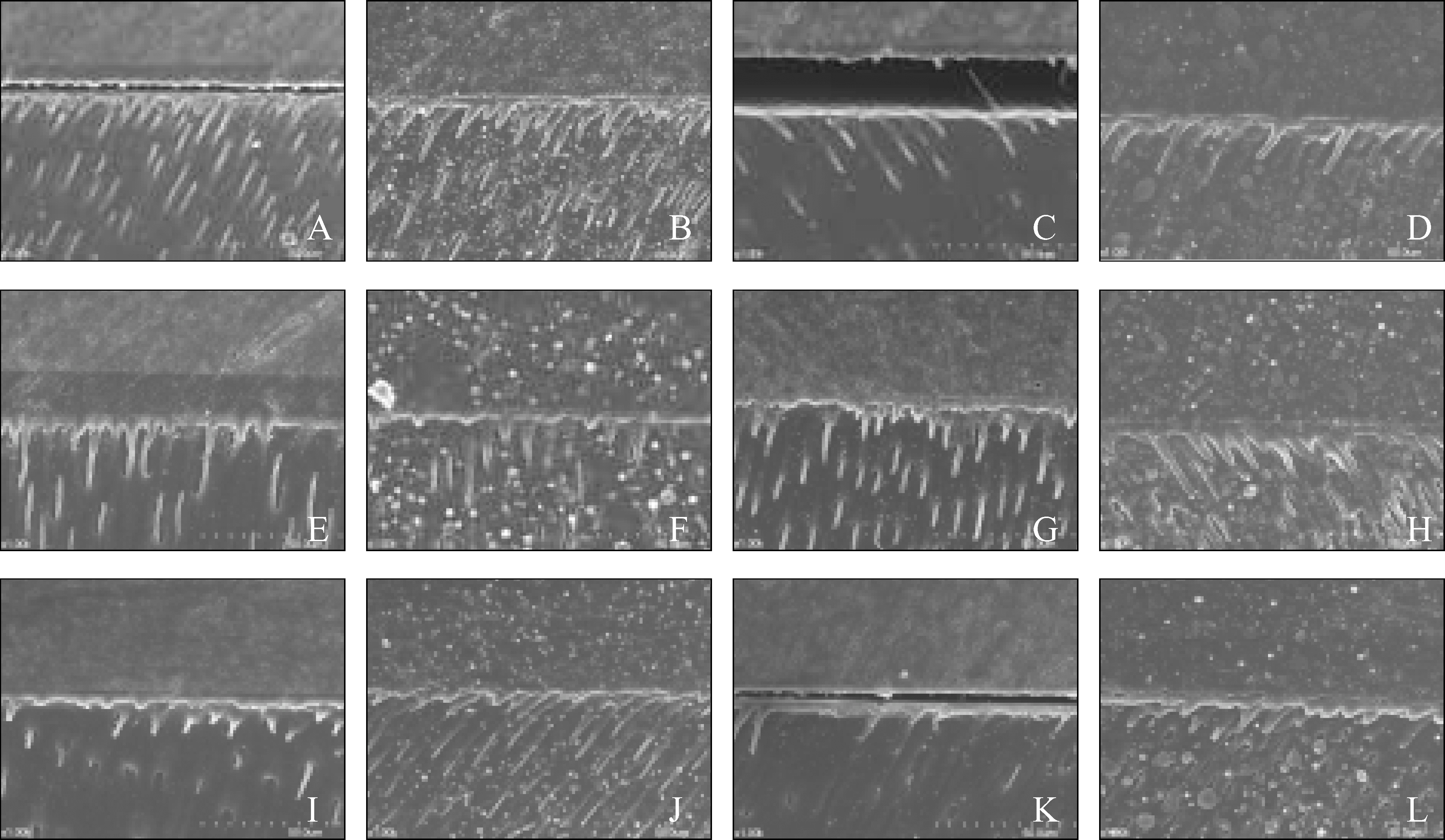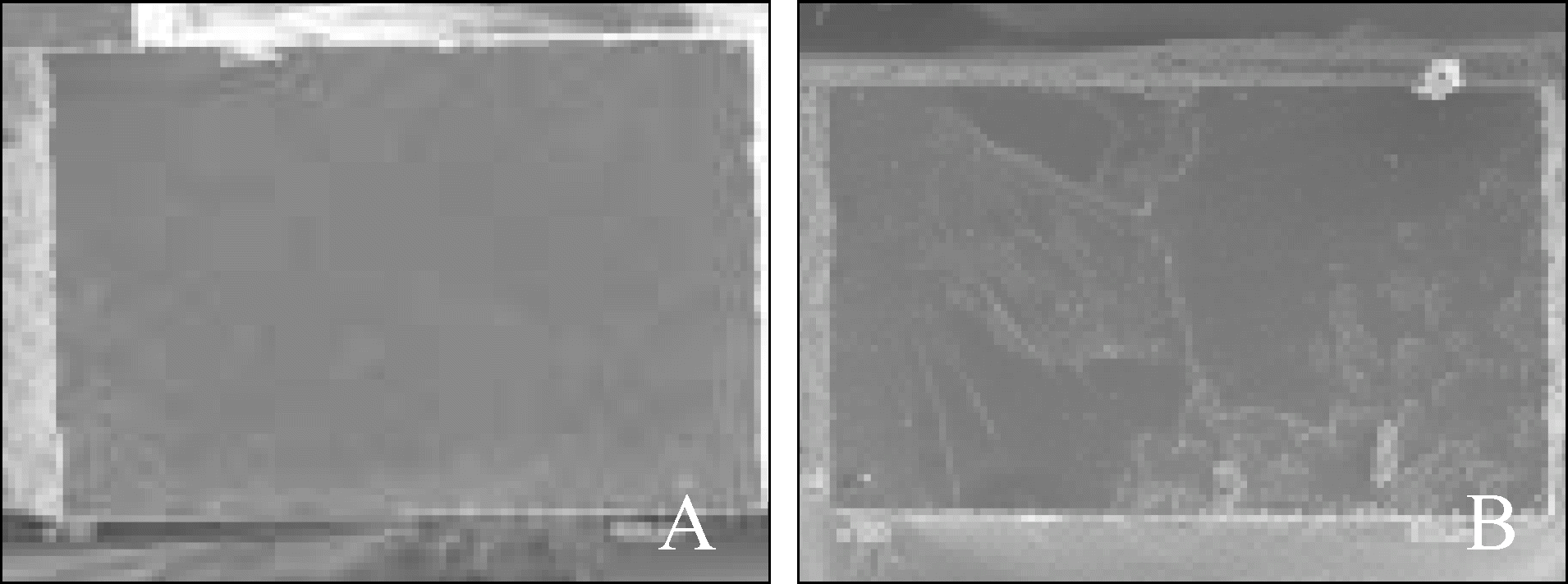Abstract
Deterioration of long-term dentin adhesion durability is thought to occur by hydrolytic degradation within hydrophilic domains of the adhesive and hybrid layers. This study investigated the hypothesis that priming the collagen network with an organic solvent displace water without collapse and thereby obtain good bond strength with an adhesive made of hydrophobic monomers and organic solvents. Three experimental adhesives were prepared by dissolving two hydrophobic monomers, bisphenol-A-glycidylmethacrylate (Bis-GMA) and triethylenegly-col dimethacrylate (TEGDMA), into acetone, ethanol or methanol. After an etching and rinsing procedure, the adhesives were applied onto either wet dentin surfaces (wet bonding) or dentin surfaces primed with the same solvent (solvent-primed bonding). Microtensile bond strength (MTBS) was measured at 48 hrs, 1 month and after 10,000 times of thermocycles. The bonded interfaces were evaluated using a scanning electron microscope (SEM). Regardless of bonding protocols, well-developed hybrid layers were observed at the bonded interface in most specimens. The highest mean MTBS was observed in the adhesive containing ethanol at 48 hrs. With solvent-primed bonding, increased MTBS tendencies were seen with thermocycling in the adhesives containing ethanol or methanol. However, in the case of wet bonding, no increase in MTBS was observed with aging.
References
1. Nakabayashi N, Kojima K, Masuhara E. The promotion of adhesion by the infiltration of monomers into tooth substrates. J Biomed Mater Res. 16:265–273. 1982.

2. Rosales-Leal JI, Osorio R, Holgado-Terriza JA, Cabrerizo-Vilchez MA, Toledano M. Dentin wetting by four adhesive systems. Dent Mater. 17:526–532. 2001.

3. Eliades G, Vougiouklakis G, Palaghias G. Heterogeneous distribution of single-bottle adhesive monomers in the resin-dentin interdiffusion zone. Dent Mater. 17:277–283. 2001.

4. Wang Y, Spencer P. Evaluation of the interface between one-bottle adhesive systems and dentin by Goldner's trichrome. Am J Dent. 18:66–72. 2005.
5. Spencer P, Wang Y. Adhesive phase separation at the dentin interface under wet bonding conditions. J Biomed Mater Res. 62:447–456. 2002.

6. Spencer P, Wang Y, Lawrence K. Identification of collagen encapsulation at the dentin/adhesive interface. J Adhes Dent. 6:91–95. 2004.
7. Tay FR, Pashley DH, Suh BI, Carvalho RM, Itthagarun A. Single-step adhesives are permeable membranes. J Dent. 30:371–382. 2002.

8. Tay FR, Frankenberger R, Krejci I, Bouillaguet S, Pashley DH, Carvalho RM, Lai CNS. Single-bottle adhesives behave as permeable membranes after polymerization. I. In vivo evidence. J Dent. 32:611–621. 2004.

9. Armstrong SR, Vargas MA, Qian F, Laffoon JE. Microtensile bond strength of a total-etch 3-step, total-etch 2-step, self-etch 2-step, and a self-etch 1-step dentin bonding system through 15-month water storage. J Adhes Dent. 5:47–56. 2003.
10. Tay FR, Hashimoto M, Pashley DH, Peters MC, Lai SCN, Yiu CKY, Cheong C. Aging affects two modes of nanoleakage expression in bonded dentin. J Dent Res. 82:537–541. 2003.

11. De Munck J, Van Meerbeek B, Yoshida Y, Inoue S, Vargas M, Suzuki K, Lambrechts P, Vanherle G. Four-year water degradation of total-etch adhesives bonded to dentin. J Dent. 82:136–140. 2003.

12. Hashimoto M, Ohno H, Sano H, Kaga M, Oguchi H. In vitro degradation of resin-dentin bonds analyzed by microtensile bond test, scanning and transmission electron microscopy. Biomaterials. 24:3795–3803. 2003.

13. Son SJ, Chang JG, Kang SH, Yoo HM, Cho BH, Son HH. The nanoleakage patterns of experimental hydrophobic adhesive after load cycling. J Kor Acad Cons Dent. 33(1):9–19. 2008.
14. Fukushima T, Inoue Y, Miyazaki K, Itoh T. Effect of primers containing N-methylolacrylamide or N-methy-lolmethacrylamide on dentin bond durability of a resin composite after 5 years. J Dent. 29:227–234. 2001.

15. Nakajima M, Okuda M, Ogata M, Pereira PN, Tagami J, Pashley DH. The durability of a fluoride-releasing resin adhesive system to dentin. Oper Dent. 28:186–192. 2003.
16. Osorio R, Erhardt MC, Pimenta LA, Osorio E, Toledano M. EDTA treatment improves resin-dentin bonds’ resistance to degradation. J Dent Res 5;. 84:736–740. 2005.

17. Maciel KT, Carvalho RM, Ringle RD, Preson CD, Russell CM, Pashley DH. The effects of acetone, ethanol, HEMA, and air on the stiffness of human decalcified dentin matrix. J Dent Res. 75:1851–1858. 1996.

18. Fukuda K, Nezu T, Terada Y. The effects of alcoholic compounds on the stability of type I collagen studied by differential scanning calorimetry. Dent Mater J. 19:221–228. 2000.
19. Nakabayashi N, Watanabe A, Gendusa NJ. Dentin adhesion of “modified”4-META/MMA-TBB resin: function of HEMA. Dent Mater. 8:259–264. 1992.
20. Perdigao J, Frankenberger R. Effect of solvent and rewetting time on dentin adhesion. Qunitessence Int. 32:385–390. 2001.
21. Cho BH, Dickens SH. Effects of the acetone content of single solution dentin bonding agents on the adhesive layer thickness and the microtensile bond strength. Dent Mater. 20:107–115. 2004.

22. Mohan B, Kandaswamy D. A confocal microscopic evaluation of resin-dentin interface using adhesive systems with three different solvents bonded to dry and moist dentin-An in vitro study. Quintessence Int. 36:511–521. 2005.

23. Rosenblatt J, Devereux B, Wallace DG. Injectable collagen as a pH-sensitive hydrogel. Biomaterials. 15:985–995. 1994.

24. Carvalho RM, Yoshiyama M, Brewer PD, Pashley DH. Dimensional changes of demineralized human dentine during preparation for scanning electron microscopy. Arch Oral Biol. 41:379–386. 1996.

25. Asmussen E, Peutzfeldt A. Short- and Long-term bonding efficacy of a self-etching, one-step adhesive. J Adhes Dent. 5:41–45. 2003.
26. Miguez PA, Pereira MP, Swift EJ Jr. One-year tensile bond strengths of two self-etching primers to bovine enamel. J Esthet Restor Dent. 16:243–248. 2004.

27. Park JS, Kim JS, Kim MS, Son HH, Kwon HC, Cho BH. Aging effect on the microtensile bond strength of self-etching adhesives. J Kor Acad Cons Dent. 31(6):415–426. 2006.

28. Takahashi A, Inoue S, Kawamoto C, Ominato R, Tanaka T, Sato Y, Pereira PN, Sano H. In vivo longterm durability of the bond to dentin using two adhesive systems. J Adhes Dent. 4:151–159. 2002.
29. Nakajima M, Okuda M, Ogata M, Pereira PN, Tagami J, Pashley DH. The durability of a fluoride-releasing resin adhesive system to dentin. Oper Dent. 28:186–192. 2003.
30. Armstrong SR, Vargas MA, Chung I, Pashley DH, Campbell JA, Laffoon JE, Qian F. Resin-dentin interfacial ultrastructure and microtensile dentin bond strength after five-year water storage. Oper Dent. 29:705–712. 2004.
31. Frankenberger R, Strobel WO, Lohbauer U, Kramer N, Petschelt A. The effect of six years of water storage on resin composite bonding to human dentin. J Biomed Mater Res B Appl Biomater. 69(1):25–32. 2004.

Figure 1.
Microtensile bond strength (MPa) of three experimental adhesives according to the bonding protocols and measuring times.

Figure 2.
Scanning electron microscopic images of the bonded interfaces. a & b, the adhesive containing acetone was applied on acetone-primed dentin after etching and rinsing procedure; c & d, the adhesive containing acetone was applied with wet bonding protocol; e & f, the adhesive containing ethanol was applied on ethanol-primed dentin after etching and rinsing procedure; g & h, the adhesive containing ethanol was applied with wet bonding protocol; i & j, the adhesive containing methanol was applied on methanol-primed dentin after etching and rinsing procedure; k & l, the adhesive containing methanol was applied with wet bonding protocol. Left column, the micrographs taken directly from the specimens; Right column, those taken from the replica of the specimens.

Figure 3.
Fractured surfaces of the bonded specimens. a, dentin side of fractured specimen bonded with adhesive containing methanol using wet bonding. Most failures occurred between the hybrid layer and the adhesive layer. b, dentin side of fractured specimen bonded with adhesive containing ethanol using solvent-primed bonding. In this group, most of the specimens showed mixed fracture.

Figure 4.
Scanning electron microscopic images of the bonded interfaces after thermocycling. a, the adhesive containing acetone was applied with wet bonding protocol; b, the adhesive containing methanol was applied with wet bonding; c, the adhesive containing methanol was applied on methanol-primed dentin after etching and rinsing procedure. With wet bonding protocol, the interfacial gaps were still observed at the same interface as the specimens observed at 48 hrs. However, with solvent-primed bonding protocol, well-developed hybrid layers and a number of long resin tags were observed without apparent interfacial gap.

Table 1.
Materials used for the preparation of the experimental resin adhesives
Table 2.
Microtensile bond strengths of experimental adhesives with different bonding protocols and measuring times (MTBS, unit: MPa)
| Adhesives | Bonding protocol |
Measuring time |
||
|---|---|---|---|---|
| 48 hours | 1 month | Thermocycling | ||
| Ac-containing | Solvent primed bonding | 14 ± 4.9(13) * | 17.4 ± 8.7(17) | 18.1 ± 8.3(15) |
| Wet bonding | 9.7 ± 4.3(19) | 8.8 ± 3.5(9) | 12 ± 5.8(8) | |
| Et-containing | Solvent primed bonding | 38.9 ± 13(21) | 40.4 ± 16.2(17) | 50.3 ± 10.2(14) |
| Wet bonding | 33.1 ± 9.2(15) | 27.6 ± 12.3(14) | 27.6 ± 11.7(14) | |
| Me-containing | Solvent primed bonding | 15.2 ± 6.8(23) | 19.1 ± 8.7(12) | 60.7 ± 10.6(10) |
| Wet bonding | 12.8 ± 9.4(19) | 22.6 ± 9.7(14) | 21.6 ± 4.2(9) | |




 PDF
PDF ePub
ePub Citation
Citation Print
Print


 XML Download
XML Download